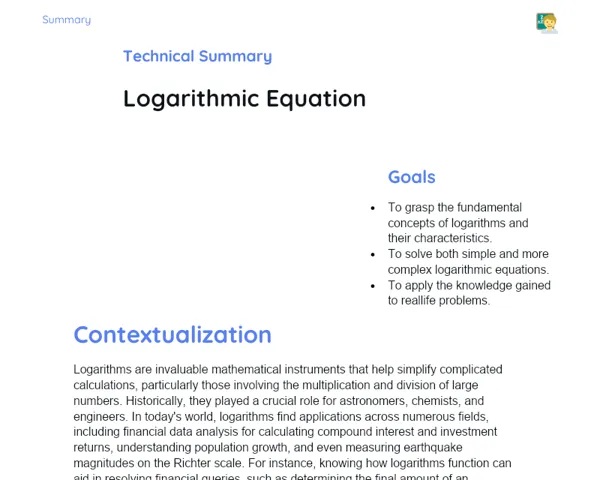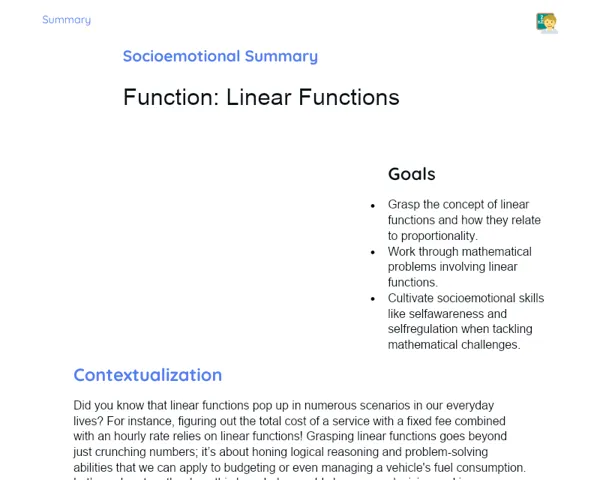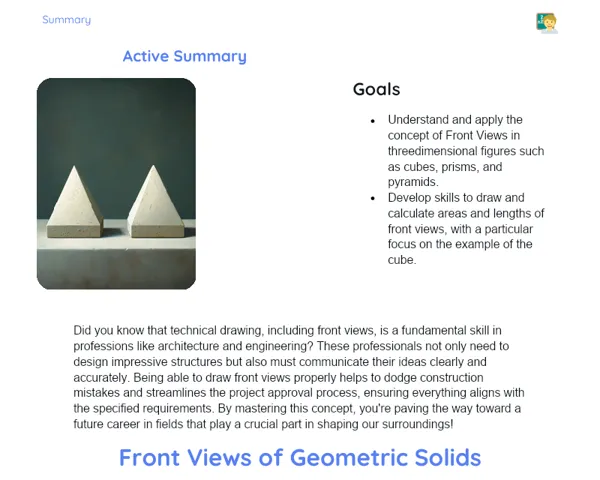Summary Tradisional | Hexagon Area
Contextualization
A hexagon is a geometric shape made up of six sides. When all these sides and angles are equal, we call it a regular hexagon. This shape has unique properties that make figuring out its area much simpler, which is a useful skill not only in mathematics but also in everyday life.
You can easily calculate the area of a regular hexagon using a specific formula that we'll explore in this lesson. Understanding how to calculate the area of this shape is particularly handy in practical situations. For example, in architecture, hexagonal designs can be utilized for floors and walls. In nature, bee hives are hexagonally structured to optimize space and material usage.
To Remember!
Concept of Regular Hexagon
The regular hexagon is a geometric shape with six equal sides and six equal internal angles. Each internal angle measures 120 degrees, and all sides have the same length. This symmetry makes hexagons particularly interesting and useful in various practical applications, like designing structures.
Moreover, a regular hexagon can be divided into six equilateral triangles, which makes calculating its area easier. We know how to find the area of an equilateral triangle, and this knowledge helps in determining the total area of the hexagon.
Getting a grip on the concept of the regular hexagon is key for applying mathematical formulas accurately. This figure is often studied in geometry due to its special properties, which streamline calculations and optimization tasks.
-
A regular hexagon has six sides and six equal internal angles.
-
Each internal angle of the regular hexagon measures 120 degrees.
-
It can be divided into six equilateral triangles.
Area Formula for Regular Hexagon
The formula for calculating the area of a regular hexagon is based on the area of an equilateral triangle. Since a regular hexagon can be split into six equilateral triangles, we calculate the area of one triangle and multiply by six to get the total area of the hexagon.
The formula to find the area of a regular hexagon is A = (3√3/2) * L², where 'L' is the side length. This comes from the fact that each equilateral triangle has an area of (√3/4) * L², and the hexagon comprises six of these triangles.
Using this formula in practical scenarios only requires measuring the hexagon’s side, making it straightforward to calculate the area for things like floor plans or construction projects.
-
The formula for the area of a regular hexagon is A = (3√3/2) * L².
-
The formula is derived from the area of equilateral triangles.
-
It simplifies the calculation of area in practical problems.
Practical Applications of Hexagon Area Calculation
Knowing how to calculate the area of a regular hexagon opens the door to various practical applications. In architecture, hexagons are often incorporated into floor and wall designs for their space efficiency and aesthetic appeal, eliminating gaps and maximizing material usage while also creating visually striking patterns.
In the world of biology, bee hives are composed of hexagonal cells, a shape that nature selected for optimal space and material efficiency. Each hexagonal cell maximizes honey storage while minimizing wax, neatly illustrating how geometric principles are applied in nature.
Additionally, calculating hexagon areas is useful in optimization tasks and any context involving surface coverage with regular shapes. This geometric knowledge has applications across various fields, making it a valuable tool.
-
Hexagons are used in flooring and wall design in architecture.
-
Bee hives capitalize on hexagonal cells to optimize space and material.
-
Useful in optimization tasks and surface coverage.
Problem Solving with Hexagons
Tackling problems involving hexagons calls for properly applying the area formula while understanding the geometric characteristics of shapes. For instance, if you want to find the area of a regular hexagon with a side length of 8 cm, you can substitute this value into the formula A = (3√3/2) * L². The process is clear and follows logical steps.
Another common problem is figuring out the total area of a hexagon that has been divided into equilateral triangles. If you know the area of each triangle, summing up the areas of the six will yield the hexagon's total area. This technique is particularly helpful when breaking shapes down into triangles for better understanding.
These types of problems frequently come up in educational settings and practical situations, whether it's finding the area of a hexagonal room or calculating the materials needed to cover a hexagonal surface. Working on such problems strengthens vital skills in mathematics and logical reasoning.
-
Application of the area formula in real-world problems.
-
Dividing the hexagon into equilateral triangles for easier calculations.
-
Fostering skills in mathematics and logical reasoning.
Key Terms
-
Regular Hexagon: A geometric shape with six equal sides and angles.
-
Equilateral Triangle: A triangle with three equal sides and angles.
-
Area Formula: A mathematical expression used to calculate the area of a shape.
-
Spatial Efficiency: The effective use of available space, minimizing wastage.
-
Practical Application: Utilizing theoretical concepts in everyday contexts.
Important Conclusions
Throughout this lesson, we explored the concept of the regular hexagon and its unique properties that facilitate area calculations. We learned the specific formula for determining its area, derived from the areas of the equilateral triangles that comprise the shape. Additionally, we examined various practical applications ranging from biology with bee hives to architecture in floor design.
The understanding gained around calculating hexagon areas is crucial in a variety of practical fields. This geometry knowledge allows for effective resolution of problems involving space and material efficiency, showcasing its real-world relevance. Practicing these calculations helps develop important mathematical and logical reasoning skills that are advantageous in both everyday and professional contexts.
We encourage students to keep delving into the subject, as the geometry of hexagons connects with many other concepts and areas of knowledge. Applying this understanding in practical scenarios reinforces its significance, and a natural curiosity may lead to more intriguing discoveries about the role of mathematics in our world.
Study Tips
-
Review the area formula for a regular hexagon and try different side lengths to grasp the concept better.
-
Explore real-world problems involving hexagons, like floor design or calculations concerning hives, to visualize practical applications.
-
Research further into hexagon properties and other regular geometric shapes. Comparing area formulas and applications broadens your understanding of geometry.



